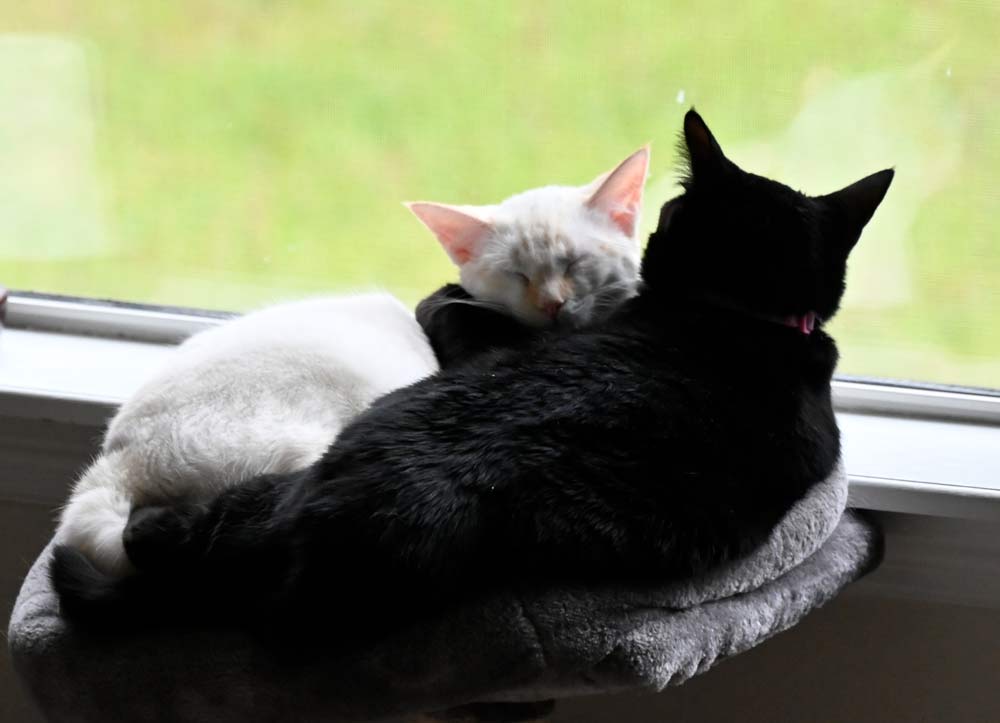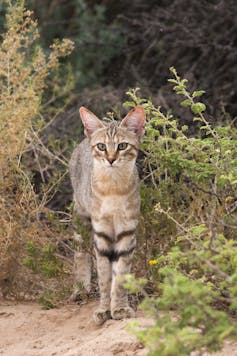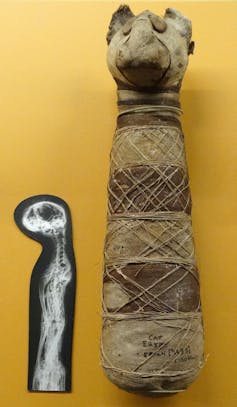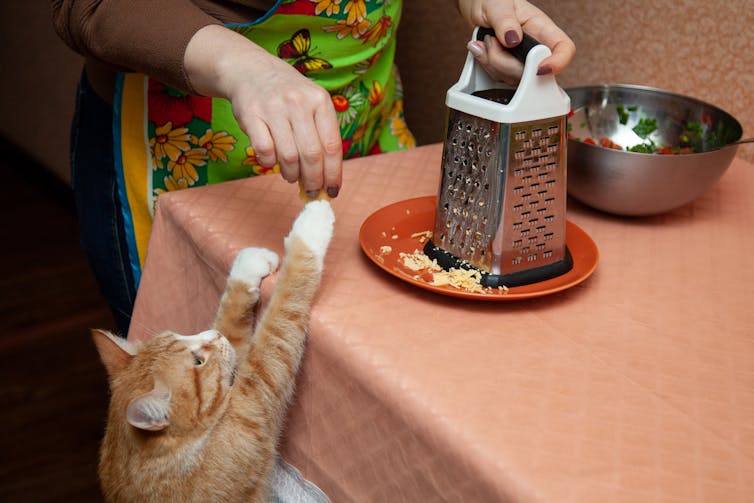
By Jonathan Losos
A few years ago, I had the opportunity to go on safari in Southern Africa. One of the greatest sensations was going out at night in search of lurking predators: lions, leopards, hyenas.
However, as we drove through the darkness, our searchlight occasionally shone on a smaller hunter – a slender, tawny feline, lightly spotted or striped. The glare caught the little cat for a moment before it slipped back into the shadows.

pum_eva/iStock via Getty Images Plus
Based on its size and appearance, I initially assumed it was someone’s pet inexplicably in the bush. But closer examination revealed distinguishing features: slightly longer legs than most domestic cats and a conspicuous black-tipped tail. Yet if you saw one from your kitchen window, your first thought would be “Look at that beautiful cat in the garden,” not “How did that African wildcat get all the way to New Jersey?”
As an evolutionary biologistI spent my career study how species adapt to their environment. My research has focused on reptiles, studying the functioning of natural selection on lizards.
However, I have always loved and fascinated felines, since we adopted a shelter cat when I was 5 years old. And the more I thought about these African wildcats, the more I marveled at their evolutionary success. The fame of the species is simple: The African wildcat is the ancestor of our beloved pets. And despite very few changes, their descendants have become one of the two most popular pets in the world. (Numbers are fuzzy, but the world population of cats And dogs approaches a billion for each.)
Clearly, the few evolutionary changes brought about by the domestic cat were the right ones to find their way into people’s hearts and homes. How did they do it? I explored this question in my book “The cat’s meow: how cats evolved from the savannah to your couch.”
Why the African wildcat?
Big cats – like lions, tigers and cougars – are the celebrities that grab the attention of the cat world. But of 41 species of wild felines, the vast majority are about the size of a domestic cat. Few people have heard of the black-footed cat or the Borneo bay cat, let alone the kodkod, oncilla or marbled cat. Obviously, the little cat side of the feline family needs a better public relations agent.
In theory, any of these species could have been the ancestor of the domestic cat, but recent DNA studies unequivocally demonstrate that today’s domestic cats are descended from the African wildcat – specifically the North African subspecies, Felis silvestris lybica.
Faced with the profusion of small kittens, why is the North African wildcat the one who gave birth to our housemates?
In short, it was the right species in the right place at the right time. Civilization has begun in the fertile crescent around 10,000 years ago when people first settled in villages and started growing food.
This area – which spans parts of present-day Egypt, Turkey, Syria, Iran and other regions – is is home to many small cats, including the caracal, serval, jungle cat and sand cat. But among these, the African wildcat is the one that, to this day, enters villages and can be found around humans.
African wildcats are among the friendliest feline species; lifted gently, they can make affectionate companions. In contrast, despite the most tender attentions, their close relative the European wildcat grows up and becomes terribly wicked.
Given these trends, it is easy to imagine what probably happened. People moved in and started farming, storing the surplus for the lean seasons. These granaries led to an explosion in the rodent population. Some African wildcats – those least afraid of humans – took advantage of this bounty and started hanging around. People saw the benefit of their presence and treated the cats kindly, perhaps giving them shelter or food. The most daring cats entered the huts and perhaps let themselves be petted: the kittens are adorable! – and lo and behold, the domestic cat was born.

Universal History Archive/Universal Images Group via Getty Images
It is not known exactly where the domestication took place – whether it was in one place and not simultaneously throughout the region. But funerary paintings and sculptures show that 3,500 years ago domestic cats lived in Egypt. Genetic analysis – including DNA from Egyptian cat mummies – and archaeological data trace the feline diaspora. They moved north through Europe (and eventually to North America), south deeper into Africa, and east into Asia. Ancient DNA even demonstrates that The Vikings played a role in the spread of big cats far and away.
What traits of the cat has domestication enhanced?
Domestic cats have many coat colors, patterns and textures not found in feral cats. A few cat breeds have distinctive physical characteristics, such as the short legs of the Munchkins, Elongated faces of the Siamese Or The lack of muzzle of the Persians.
Yet many domestic animals seem basically indistinguishable from feral cats. In fact, only 13 genes have been modified by natural selection during the domestication process. However, almost three times more modified genes during the descent of the dogs of the wolves.
There are only two ways to positively identify a feral cat. You can measure the size of his brain – domestic cats, like other pets, developed reductions in parts of the brain associated with aggression, fear, and overall reactivity. Or you can measure the length of his intestines – longer in domestic cats to digest vegetable-based foods provided or scavenged by humans.
The most important evolutionary changes during the domestication of the cat concern their behavior. The common view that house cats are aloof loners couldn’t be further from the truth. When many domestic cats live together – in places where humans provide large amounts of food – they form social groups very similar to the prides of lions. Made up of related females, these cats are very friendly: they groom each other, play with and lie on top of each other, nurse each other’s kittens and even serve as midwives during childbirth. .
To signal friendly intentions, an approaching cat raises its tail up, a trait shared with lions and no other feline species. As anyone who’s lived with a cat knows, they also use that “I want to be friends” message towards people, indicating that they include us in their social circle.

Nail Galiev/iStock via Getty Images Plus
Evolution of a master manipulator
Domestic cats talk a lot to their human companions, using different meows to communicate different messages. However, unlike the tailed up display, this is not an example of how they treat us as part of their clan. On the contrary, cats rarely meow to each other.
The sound of these meows has evolved during domestication to communicate more effectively with us. Listeners find the call of the wild cat to be more urgent and demanding (“Mee-O-O-O-O-O-W!”) than the more pleasant domestic cat (“MEE-ow”). Scientists suggest that these shorter, higher-pitched sounds are more pleasing to our auditory systemperhaps because young humans have high-pitched voices and domestic cats evolved accordingly to curry favor with humans.
The same cats manipulate people with their purrs. When they want something – imagine a cat rubbing against your legs in the kitchen while you open a box of wet food – they purr very loudly. And that purr is not the pleasant whirring of a happy cat, but an insistent chainsaw sound demanding attention.
Scientists have numerically compared the spectral qualities of the two types of purrs and discovered that the major difference is that the insistent purr includes a component very similar to the sound of a human baby crying. People, of course, are naturally suited to this soundand cats have evolved to take advantage of this sensitivity to get our attention.
Of course, this will come as no surprise to anyone who has lived with a cat. Although cats are very trainable – they are very food motivated – cats usually train us more than we train them. As the old saying goes, “Dogs have owners, cats have staff.”
![]()
Jonathan Losos is the William H. Danforth Professor Emeritus of Arts and Sciences at Washington University in St. Louis.
The conversation was born out of deep-rooted concerns about the diminishing quality of our public discourse and recognition of the vital role that academic experts could play in the public space. Information has always been essential to democracy. It is a societal good, like drinking water. But many now find it hard to trust the media and experts who have spent years studying a subject. Instead, they listen to those with the loudest voices. These ill-informed opinions are amplified by social media that rewards those who spark outrage instead of thoughtful reflection or discussion. The Conversation seeks to be part of the solution to this problem, to bring the voices of real experts to the table and make their knowledge available to everyone. The Conversation publishes nightly at 9 p.m. on FlaglerLive.



